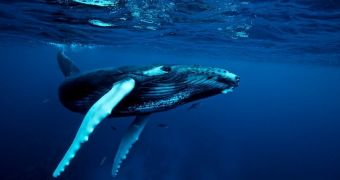According to a new paper published in the journal Conservation Biology, humpback whales swimming in the waters off western Africa's coast have oil rigs, ships, and even toxicants to keep them company, just in case they might get bored while exploring the region.
Otherwise put, there is a significant overlap between areas populated by such marine mammals and offshore drilling regions and major shipping routes.
What's more, some of the waters that humpback whales visit are contaminated with harmful chemical compounds, the Wildlife Conservation Society (WCS, for short) explains on its website.
“Throughout numerous coastal and offshore areas, important whale habitats and migration routes are increasingly overlapping with industrial development, a scenario we have quantified for the first time in the eastern South Atlantic,” Dr. Howard Rosenbaum with the WCS says.
In order to determine whether humpback whales that travel to western African waters in order to find suitable mates or deliver offspring swim alone or are disturbed by human activities, researchers tagged fifteen such marine mammals.
They later monitored their movements in the region, and were able to get a better idea of what humpback whales are up to once they arrive in African waters.
By the looks of it, the whales monitored as part of this study spent 76% of their time swimming in the Exclusive Economic Zones (i.e. 200 nautical miles from the coast) of as many as 13 different countries.
However, it would appear that the marine mammals preferred the Exclusive Economic Zones of Cameroon, Gabon, Nigeria, and Angola. What's more, the ones that entered and remained in Gabon's coastal waters spent about 41% of their time close to oil and gas platforms.
Apart from pinning down said overlap between whale habitat and human-related activities, researchers managed to use the information collected by means of satellite tags to find new areas that are part and parcel of the marine mammal's breeding range.
They were also able to better document the migratory routes that these animals travel on when heading towards their sub-Antarctic feeding grounds.
The data obtained as a result of this investigation is expected to help better protect humpback whales by managing economic development in such ways that it does not negatively impact on their habitat and migratory routes.
“Studies such as this one are crucial for identifying important habitats for humpback whales and how to best protect these populations from potential impacts associated with hydrocarbon exploration and production, shipping, and other forms of coastal and offshore activities,” says Dr. Howard Rosenbaum.

 14 DAY TRIAL //
14 DAY TRIAL //